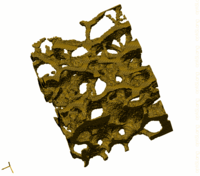This project is founded by the Deutsche Forschungsgemeinschaft DFG.
Project duration: 01.03.2010-28.02.2013
Project leader: Prof. Dr.-Ing. habil. Carsten Könke
Project employee: Dipl.-Ing. Andrea Keßler
Content

Modern image detection techniques such as micro computer tomography (µCT) enable researchers to resolve micro-structures in technical and biological materials in 3D with resolutions up to 1µm. Automated image processing techniques can transfer these image data into discredited models with very high resolution of the underlying material structure. Therewith much simpler and straightforward material laws can be applied on micro-scale without the need to perform macroscopic material experiments in order to capture anisotropy or damage and fracture effects. The project develops a method which allows to model different material on micro-scale for large-scale specimen, e.g. complete test specimen, by regular grid discretizations. The resulting equation system with a large number of degrees of freedom (dofs) can then be solved - linear or physical non-linear - by efficient iterative solver methods without necessity to build and store the global stiffness matrix.Therefor also damage simulation can be conducted. The method is applicable to different materials like bone (trabecular structure), metal foams or metals (micro-voids in aero-construction materials).
Main points of the project
- Adaptive 3D octree data structures to reduce degrees of freedom: In zones where no damage or material interface is detected coarsing of the regular grid is applied.
- Multiphase elements to depict material boundary: The material boundary in grid based models is jagged. To overcome this disadvantage the boundary has to be modeled at least C1 smooth and C0 smooth tangential to the boundary. This will be assured by special multiphase elements with the transition in one single element.
- Non-local material formulation: The modeling of the damage behavior is to perform by a non-local continuum mechanics approach adapted to the heterogeneous material zones. For each incrementell-linear solutions an adaption of damage parameter is done.
- To solve such large problems effective iterative methodes have to be adapted and developped. The conjugate gradient method with an multigrid preconditioner is applied in an element-by-element way.
